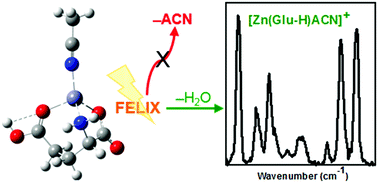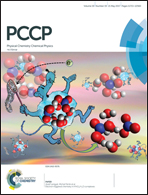Experimental and theoretical investigations of infrared multiple photon dissociation spectra of glutamic acid complexes with Zn2+ and Cd2+†
Abstract
Complexes of glutamic acid (Glu) cationized with Zn2+ and Cd2+ were examined by infrared multiple photon dissociation (IRMPD) action spectroscopy using light generated from a free electron laser. Complexes of deprotonated Glu with Zn2+, [Zn(Glu-H)ACN]+ (where ACN = acetonitrile, CH3CN), and intact Glu with CdCl+, CdCl+(Glu) were formed. Notably, photodissociation induces Glu fragmentation rather than ACN loss in the Zn2+ complex. In order to identify the structures formed experimentally, the experimentally obtained spectra were compared to those calculated from optimized structures at the B3LYP/6-311+G(d,p) level for [Zn(Glu-H)ACN]+ and B3LYP/def2-TZVP level with an SDD effective core potential on cadmium for the CdCl+(Glu) system. The main binding motif observed for the heavy metal complex is a charge solvated, tridentate [N,COs,CO] structure where the metal binds to the backbone amino group and carbonyl oxygens of the side-chain and backbone carboxylic acid groups. The Zn2+ system similarly prefers a [N,CO−,COs] binding motif, where binding is observed at one oxygen of the backbone carboxylate site along with the backbone amino and side-chain carbonyl groups. In both cases, the theoretically determined lowest-energy conformers explain the experimental [Zn(Glu-H)ACN]+ and CdCl+(Glu) spectra well.



 Please wait while we load your content...
Please wait while we load your content...